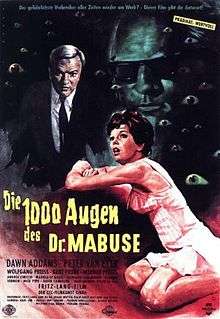The Thousand Eyes of Dr. Mabuse
| Die 1000 Augen des Dr. Mabuse | |
|---|---|
 | |
| Directed by | Fritz Lang |
| Produced by | Artur Brauner |
| Written by |
Fritz Lang Heinz Oskar Wuttig |
| Based on |
Mr. Tot Aĉetas Mil Okulojn by Jan Fethke |
| Starring |
Dawn Addams Peter van Eyck Gert Fröbe |
| Music by |
Bert Grund Werner Müller |
| Cinematography | Karl Löb |
| Edited by |
Walter Wischniewsky Waltraut Wischniewsky |
Production company |
|
| Distributed by | Prisma Filmverleih GmbH |
Release dates |
|
Running time | 103 minutes |
| Country |
|
| Language | German |
The Thousand Eyes of Dr. Mabuse (Ger. Die 1000 Augen des Dr. Mabuse) is a 1960 black-and-white crime film/thriller made in West Germany. It was a West German/French/Italian international co-production and the last film directed by Fritz Lang. It starred Peter van Eyck, Dawn Addams and Gert Fröbe. The film made use of the character Dr. Mabuse, who had appeared in earlier films by Lang back in 1922 and 1933. The Thousand Eyes of Dr. Mabuse spawned a film series of German "Mabuse" films that were released over the following years to compete with Rialto Film's Krimi films.
Plot
A reporter is killed in his car on his way to work. Inspector Kras gets a call from his informant Peter Cornelius, a blind fortune-teller, who had a vision of the crime but not the perpetrator. Meanwhile, Henry Travers, a rich American industrialist, checks into the Luxor Hotel, which has been outfitted by the Nazis during World War II to spy on people in every room. He becomes involved with Marian Menil who is being threatened by her evil clubfooted husband. Hieronymus B. Mistelzweig, purportedly a salesman, who is also a guest in the hotel always seems to be lurking about. These disparate characters eventually get together to solve what appears to be the re-emergence of the long-dead Dr. Mabuse.
Cast
- Peter van Eyck as Henry Travers
- Dawn Addams as Marion Menil
- Gert Fröbe as Inspector Kras
- Werner Peters as Hieronymus B. Mistelzweig
- Wolfgang Preiss as Professor S. Jordan / Dr. Mabuse
- Lupo Prezzo (Wolfgang Preiss) as Peter Cornelius
- Andrea Checchi as Hoteldetektiv Berg
- Howard Vernon as No. 12
- David Cameron as Michael Parker
- Reinhard Kolldehoff as Roberto Menil
Production
The Thousand Eyes of Dr. Mabuse was co-produced by CCC Filmkunst (West Germany), C.E.I. Incom (Italy) and Critérion Film (France). The original titles were Die 1000 Augen des Dr. Mabuse (German), Il diabolico Dr. Mabuse (Italian) and Le diabolique docteur Mabuse (French).[4]
It was the last film directed by Fritz Lang, who had returned from the US to Germany to make what would turn out to be a total of three films for producer Artur Brauner: The Tiger of Eschnapur, The Indian Tomb and The Thousand Eyes of Dr. Mabuse. The film made use of the character Dr. Mabuse invented by Norbert Jacques, whom Lang had used in two previous films back in 1922 (Dr. Mabuse, der Spieler, 2 parts) and 1933 (Das Testament des Dr. Mabuse).
The script of this movie, written by Fritz Lang and Heinz Oskar Wuttig was based on the Esperanto novel Mr. Tot buys a thousand eyes by the Polish author Jan Fethke. It brought the Mabuse character from his previous pre-war appearances into contemporary times (the 1960s) and combined elements of the German Edgar Wallace film series, spy fiction and Big Brother surveillance with the nihilism of the Mabuse world.
Filming took place 5 May to 28 June 1960 at the CCC Studios in Berlin. The film premiered on 14 September 1960 at the Gloria-Palast in Stuttgart (Germany) and on 28 June 1961 in Paris (French version).[4]
Sequels
The film spawned a number of sequels, all made in a similar style and produced by Artur Brauner:
- The Return of Doctor Mabuse (1961), directed by Harald Reinl.
- The Invisible Dr. Mabuse (1962), directed by Harald Reinl.
- Das Testament des Dr. Mabuse (1962), directed by Werner Klingler, a remake of the film by Fritz Lang released in 1933.
- Scotland Yard jagt Dr. Mabuse (1963), directed by Paul May.
- Die Todesstrahlen des Dr. Mabuse (1964), directed by Hugo Fregonese.
See also
Notes
- ↑ "Credits". BFI Film & TV Database. London: British Film Institute. Retrieved December 10, 2012.
- ↑ Erickson, Hal. "The 1000 Eyes of Dr. Mabuse". Allmovie. Rovi Corporation. Retrieved December 10, 2012.
- ↑ "Die Tausend Augen des Dr. Mabuse". BFI Film & TV Database. London: British Film Institute. Retrieved December 10, 2012.
- 1 2 "Filmportal: Die tausend Augen des Dr. Mabuse". Retrieved 21 March 2013.
External links
- The Thousand Eyes of Dr. Mabuse at the Internet Movie Database
- The Thousand Eyes of Dr. Mabuse at AllMovie
- Artur-Brauner-Archive at the Deutsches Filmmuseum in Frankfurt (German), containing the production files for this movie